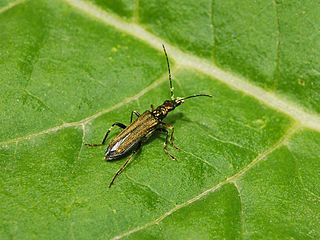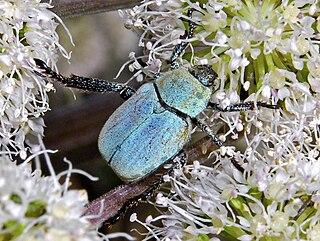
The insects of the beetle family Chrysomelidae are commonly known as leaf beetles, and include over 37,000 species in more than 2,500 genera, making up one of the largest and most commonly encountered of all beetle families. Numerous subfamilies are recognized, but the precise taxonomy and systematics are likely to change with ongoing research.

Fraxinus pennsylvanica, the green ash or red ash, is a species of ash native to eastern and central North America, from Nova Scotia west to southeastern Alberta and eastern Colorado, south to northern Florida, and southwest to Oklahoma and eastern Texas. It has spread and become naturalized in much of the western United States and also in Europe from Spain to Russia.

The Tenebrionoidea are a very large and diverse superfamily of beetles. It generally corresponds to the Heteromera of earlier authors.

Dynastes tityus, the eastern Hercules beetle, is a species of rhinoceros beetle native to the Eastern United States. The adult's elytra are green, gray or tan, with black markings, and the whole animal, including the male's horns, may reach 60 mm (2.4 in) in length. The larvae feed on decaying wood from various trees.

Trichius fasciatus, the Eurasian bee beetle, is a beetle species belonging to the family Scarabaeidae, subfamily Cetoniinae.

The family Oedemeridae is a cosmopolitan group of beetles commonly known as false blister beetles, though some recent authors have coined the name pollen-feeding beetles. There are some 100 genera and 1,500 species in the family, mostly associated with rotting wood as larvae, though adults are quite common on flowers. The family was erected by Pierre André Latreille in 1810.

Cleridae are a family of beetles of the superfamily Cleroidea. They are commonly known as checkered beetles. The family Cleridae has a worldwide distribution, and a variety of habitats and feeding preferences.

The wharf borer, Nacerdes melanura, belongs to the insect order Coleoptera, the beetles. They belong to the family Oedemeridae, known as false blister beetles. Wharf borers are present in all the states of the USA except for Florida. It takes about a year to develop from an egg to an adult. The name 'wharf borer comes from the larval stage of this insect, which often lingers on pilings and timbers of wharves, especially along coastal areas. The adult beetles are identifiable via a black band across the end of both elytra. In addition, wharf borers are distinct from other members of the family Oedemeridae due to the presence of a single spur on the tibia of the forelegs and the distance between both eyes. The female beetle oviposits eggs on rotten wood, on which the larvae hatch, burrow, then feed. Adults do not eat and depend on stored energy reserves accumulated as a larva. They are considered a pest because they damage wood used in building infrastructures.

Oedemera is a genus of beetles of the family Oedemeridae, subfamily Oedemerinae.

Oedemera nobilis, also known as the false oil beetle, thick-legged flower beetle or swollen-thighed beetle, is a beetle in the family Oedemeridae, a common species in Western Europe, including the south of England.

Oedemerinae are a subfamily of the false blister beetles, also known as pollen-feeding beetles. The Nacerdinae are sometimes merged here.

Clytus rhamni is a species of round-necked longhorns belonging to the family Cerambycidae, subfamily Cerambycinae.

Stenurella melanura is a flower longhorn beetle species of the family Cerambycidae, subfamily Lepturinae.

Malachius bipustulatus, the malachite beetle, is a species of soft-winged flower beetles belonging to the family Melyridae, subfamily Malachiinae.

Chrysanthia viridissima is a species of beetles belonging to the family Oedemeridae subfamily Nacerdinae.

Oedemera atrata is a species of beetle belonging to the family Oedemeridae subfamily Oedemerinae.

Oedemera flavipes is a very common species of beetle of the family Oedemeridae, subfamily Oedemerinae.

Hoplia argentea is a species of scarabaeid beetle belonging to the subfamily Melolonthinae.

Oedemera podagrariae, common name false blister beetle, is a quite common species of beetles belonging to the family Oedemeridae subfamily Oedemerinae.

Oedemera crassipes is a species of beetle belonging to the family Oedemeridae subfamily Oedemerinae.



















